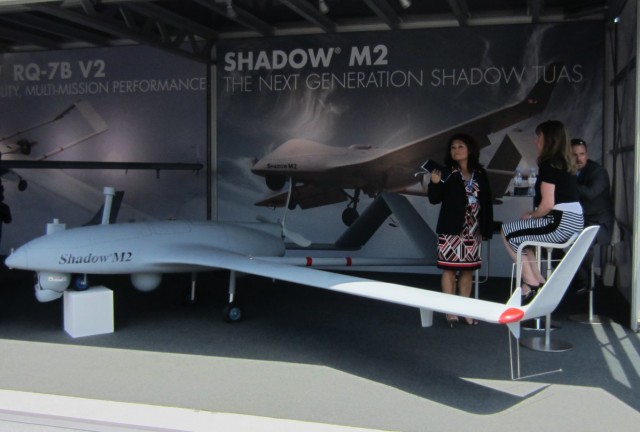 Textron Systems Unmanned Systems
Textron Systems Unmanned Systems
is showing off its range of UAVs at the Paris Air Show as the company awaits decisions on two major contracts expected later this year. In November, the French DGA is expected to down-select a contractor to meet its tactical unmanned air system (TUAS) requirement, although the decision process may be accelerated. Before then, Textron expects to find out if its bid for a U.S. Special Operations Command (SOCOM) service provision contract is successful.
For the French requirement, Textron Systems (Static A4) is teamed with prime contractor Airbus Defence &Space to offer the Shadow M2, a second-generation TUAS. The vehicle was developed with a range of improvements over the existing RQ-7 Shadow 200, including better performance and reliability.
It has dual-payload capability in its basic form, but can also carry wing-mounted payload pods to enhance multi-sensor capability. The M2 also introduces a satellite communications link that “provides more of a strategic capability in a Group 3 platform,” according to Textron Unmanned Systems Senior vice president and general manager Bill Irby. Some further modifications have been incorporated to accommodate French needs. This week the Shadow M2 is being demonstrated in the U.S. to DGA officials.
Textron’s current Shadow 200 isn’t being ignored either–it was recently given full digital datalink capability. In addition, the air vehicle is now weaponized with a number of munitions options, including Textron’s own Fury laser/GPS-guided precision weapon.
Aerosonde is the third of Textron’s UAS offerings, a smaller Group 2 (SUAS) vehicle that has been employed, as the MQ-19, by U.S. Naval Air Systems Command and SOCOM under service provision contracts. Special Operations Command is currently evaluating a third iteration of its mid-endurance UAS contract (MEUAS III) and is expected to make a decision in the late summer/early fall.
Also the object of interest from the Netherlands, the Aerosonde is a catapult-launched air vehicle that is recovered by net. A typical system comprises four air vehicles and two ground control stations that are usually accommodated in tents, although it can be tailored to fit in most vehicles. In the latest configuration, the system also includes remote video terminals that allow individual users to uplink new navigation waypoints and sensor commands to the vehicle from a ruggedized tablet-sized device, as well as receive sensor imagery and video.
Aerosonde was selected for the current MEUAS II contract, but it suffered from engine-reliability issues. Textron Unmanned Systems has worked hard with its Lycoming engine division to successfully rectify the issues. “We’ve earned our way back into SOCOM,” remarked Irby. “We’re now a model for reliability.”
Key features of the Aerosonde are its long-endurance capability, and its proven multi-mission capability to undertake up to five tasks simultaneously, including communications relay. Sensors are housed in a nose-mounted turret that is retractable to avoid damage during recovery, and in a fuselage payload bay. A quick-change payload pod can be carried conformally under the fuselage.
Besides military applications, Aerosonde is being promoted for commercial uses, and Textron already has one customer for the system in the oil/gas sector. According to Irby, this area of unmanned applications is expected to provide rapidly expanding opportunities as reliability of the systems increases yet further.
Source: AIN Online
